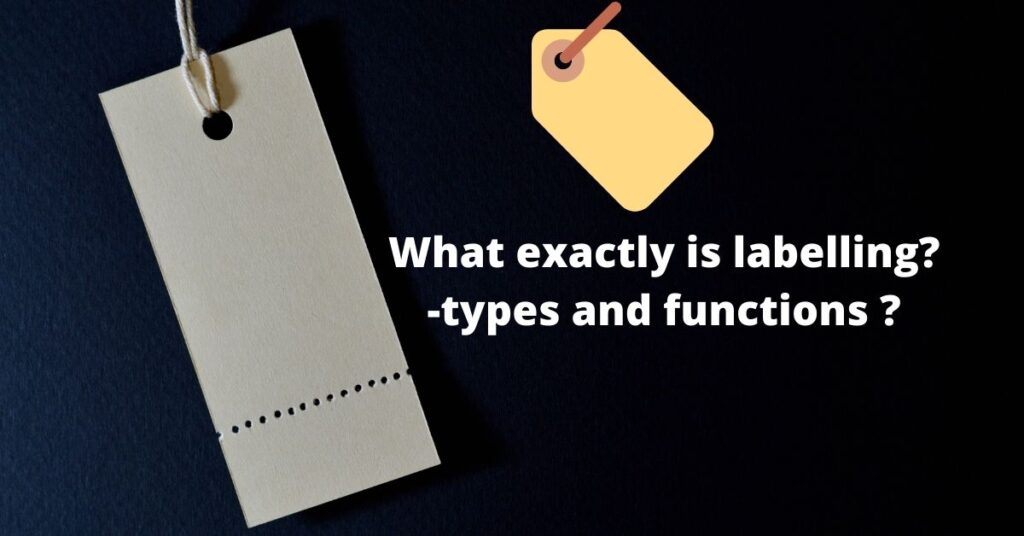Last updated on September 23rd, 2023 at 06:36 am
Do you know what is labelling and why it is very important? In today’s fast-paced world, Labels are everywhere, from the products we consume to the food we buy. These small pieces of product information play a significant role in our daily lives. It helps us to make informed decisions. Let’s dive into the concept of labelling, its functions, and various types of labelling.
Table of Contents
What is labelling?
Labelling is the process of attaching a sticker, tag, or any information panel to a package, product, or item. The main purpose of labelling is to provide essential information to consumers or users. This information can range from product details to safety warnings and usage instructions.
So, we can conclude Labelling, Any information that appears on the package that gives information to the customers refers to labelling. Information about the product is printed, pasted as well, and tagged on the package which may be written words, metal or leather pieces, etc.
Why is labelling important for branding?
Labelling is very important for brands because it enables product identification. It helps the product stand out in the market as a part of a specific brand. A well-designed label can help to increase brand visibility and secure customer loyalty. With a memorable product label businesses and brands can create trust between the product and the consumer.
Labelling is also important in terms of safety and compliance with relevant laws. In some products, it is written that the products contain some XYZ and should not be consumed by a person who is suffering from XYZ disease.
In summary, Labelling is important for branding because of the following reasons:
- Labelling enables product identification
- Labelling enables product identification
- It helps the product stand out in the competitive market.
- It helps to increase brand visibility
- It secures the customer loyalty.
- Similarly, It builds trust between the brand and the consumer
- Labelling ensures safety and compliance with relevant government laws.
Functions of labelling:
1. Identification
The main function of labelling is it helps to identify the product and its brand. similarly, labelling helps customers to identify the product and its brand.
In the same way, labelling helps customers select their desired goods because labelling makes it easier to identify the brand.
2. Grading the product
In the same way, labelling helps to grade the product because different labels can be given to different products according to their features.
similarly, level helps to grade the product according to its characteristics like quantity, quality, and so on.
3. Provide information
similarly, the label gives information and briefly describes the product. Much information about the brand or product is given in the labelling.
Much information mentioned on the label helps to know about the features of the product like quality, quantity, and so on which is really helpful for the customers.
4. protect consumer right
In the same way, the label mentions price, quality, date of expiry, and so on which protects the consumer’s rights.
Giving information about the product like manufacture date, expiry date, price, and quality helps to promote the consumer’s rights.
5. Promotion
The main function of labelling is also promotion. Labelling helps to promote the product. Attractive labelling helps to increase sales volume.
A good and attractive label helps to increase the sales volume of the product as well as helps to increase brand loyalty towards the customers.
Types of labelling:
There are different types of labelling as mentioned below:
1. Brand Label
If any brand is only used in the packaging of the product is called a brand label. In this type of label, nothing more is mentioned except the brand name.
2. Grade Label
In the same way, if the label is used to identify the grade or quality of the product is a grade label.
3. Descriptive Label
In the same way, a label that describes the product, in short, is a descriptive label. Similarly, it is known to the customers.
4. Informative label
A label that gives information about the product like using the method, protection of the product, care, and so on is the informative label.
To conclude:
Labelling refers to any information about the product that is printed, posted, and tagged on the package which may be the written words, metal as well or lather piece. Different types of labelling cater to specific needs across industries and contexts. Whether it’s product information, safety warnings, or data organization, labelling simplifies complex information and enhances communication in a fast-paced world. It’s an art and a science that continues to evolve as technology and communication methods advance.
Lebel carries verbal information about the product as well as the seller. Labelling helps to give information to the customers.
In the same way, labelling plays a very important role in the customers, sellers as well as the brand. Good and attractive labelling helps to promote the product.
similarly, the label helps to protect consumer rights as well as helps to identify the product or its brand.
Labelling is a crucial part of our everyday daily lives, serving various functions and coming in different forms. Whether you are a consumer making informed choices or a producer complying with regulations and building your brand. Understanding the significance of labelling is essential. Labelling is not just about the stickers or tags on a product. It is about the information, safety and trust it represents.



